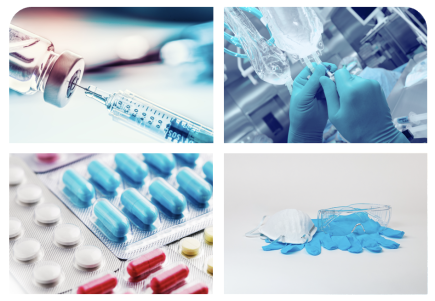Plastic is omnipresent in modern medical applications. But the very properties that make plastic desirable in health care delivery―its stability and durability―mean that we must be proactive about its management to reduce its impact on the environment.
The eye care industry―and those of us at CooperVision―care about how plastic is managed and strive to be responsible about the proper disposal and management of plastics in our products. Read on to learn about the role of plastics in health care, the concerns consumers and eye care professionals have about plastic waste, and how your practice can be part of the solution to offset the impact of plastic waste.
Health care innovation flourished with the invention of plastic

Many plastic items made health care less painful, less expensive, and more effective, from disposable syringes to intravenous blood bags to heart valves.1-3 Plastic fibers make up the filters in personal protective equipment, such as the N95, KF94, and KN95 masks, and to a lesser extent in surgical masks, used by the public and health care professionals to protect themselves from COVID-19.4 Plastics provide greater flexibility and mobility in prosthetic limbs and give smooth, working, trouble-free artificial hip and knee joints. With its exceptional barrier properties, light weight, low cost, durability, and transparency, plastic packaging is ideal for medical applications.1-3 In the future, 3D printing may yield plastic body parts, and self-healing plastic “skin” could result in new prosthetics with artificial muscle and skin that look and perform more realistically.5
In eye care, plastics have reduced the weight of eyeglass frames and lenses – and of course, plastics are a key component of contact lenses. Today, all contact lenses are made of some form of plastic, and both lenses and supplies are packaged in plastic to prevent microbial contamination for a healthy contact lens wearing experience.6,7
Patients and practitioners are increasingly environmentally conscious
We appreciate the durability of plastic when it’s protecting the pill we will eventually take or when its properties mean that a loved one’s prosthetic joint will not need replacing in their lifetime. But those same characteristics that make it ideal for those applications―its enduring nature―are why we want to make sure that we manage plastic responsibly. For example, a single plastic bottle can take 450 years to degrade under normal environmental conditions.8
Individuals and practices notice how plastic waste impacts the environment and want to take action. According to a recent survey conducted on behalf of the World Wildlife Fund, U.S. consumers are highly concerned about the impacts of plastic waste on marine life and water quality, followed by concerns about the consequences of plastic waste on human health, climate change, and to a lesser extent, air quality.9 The survey also revealed that consumers feel a sense of personal responsibility to reduce the environmental impact of plastic consumption. More than 80% of consumers strongly or somewhat agree that they’d like to recycle more, and more than 75% agree that they’d prefer products with minimal plastic packaging.9
A separate survey conducted by CooperVision echoes these findings. Ninety-four percent of patients and eye care professionals (ECPs) believe in recycling, and nearly as many agreed that keeping plastic out of the oceans was important to them.10 ECPs and consumers alike said they go out of their way to recycle and be environmentally friendly.10 It probably isn’t surprising that ECP and consumer responses were so tightly aligned; ECPs are also consumers, after all.
Meaningful action today while we work toward the innovation of tomorrow
CooperVision has a continuing legacy of sustainability. Sustainability in manufacturing is only the beginning of our story. The next phase of our journey will continue to focus on making a positive impact and improving our ability to operate more sustainably. Our approach is evolutionary, as we continually evaluate, innovate, and improve to make an impact today and in the future.
Despite a desire to be more proactive, some consumers feel helpless to avoid plastic packaging and worry about whether their actions ultimately make a difference.9 They also worry that the plastic they recycle still ends up in the ocean.9
The contact lens industry is supportive of efforts to minimize the negative effects of plastic waste, and many recycling efforts are already underway. But is recycling enough? Have you considered what else your practice can do?
It can be as easy as prescribing clariti® and MyDay® contact lenses. CooperVision is a trailblazer of net plastic neutrality.11,12 Thanks to your help in prescribing clariti® 1 day and MyDay®, we will remove the equivalent of 58 million bottles of plastic from the ocean by 2022.13
But we want to do more. Join us as we continue to make strides in our sustainability mission.
Prescribe CooperVision SiHy 1-day contact lenses and give your patients the opportunity to make an impact on the environment.
Let’s do one day better.
For more information about CooperVision’s ongoing commitment to sustainability, visit sustainability.coopervision.com.
REFERENCES
-
Naik M. 5 ways plastics revolutionized the healthcare industry. Medical Product Outsourcing. October 9, 2017. Accessed April 5, 2022. https://www.mpo-mag.com/contents/view_online-exclusives/2017-10-09/5-ways-plastics-revolutionized-the-healthcare-industry/
-
Plastics Industry Association. Why is medical plastic packaging so essential? Accessed April 5, 2022. https://thisisplastics.com/safety/why-are-medical-plastic-packages-so-essential/
-
Craftech® Industries. 4 reasons why flexible materials are improving product packaging. Accessed April 5, 2022. https://www.craftechind.com/4-reasons-why-flexible-materials-are-improving-product-packaging/
-
Health Desk. How are N95 masks made? July 30, 2021. Accessed April 5, 2022. https://health-desk.org/articles/how-are-n95-masks-made
-
Plastics Make It Possible. Innovations in medical care made possible by plastics. April 27, 2017. Accessed April 5, 2022. https://www.plasticsmakeitpossible.com/whats-new-cool/healthcare/innovations-in-medical-care-made-possible-by-plastics
-
Gleason WJ. Understanding microbiology and contact lens solutions. Contact Lens Spectrum. November 1, 2009. Accessed December 29, 2020.
-
Chetty E, Gillan WDH. Investigating the shelf life of disposable soft contact lenses. S Afr Optom. 2008;67(3):89-94.
-
World Wildlife Fund. The lifecycle of plastics. July 2, 2021. Accessed April 5, 2022. https://www.wwf.org.au/news/blogs/the-lifecycle-of-plastics
-
Corona Insights for the World Wildlife Fund. Public opinion surrounding plastic consumption and waste management of consumer packaging. 2020. https://files.worldwildlife.org/wwfcmsprod/files/Publication/file/7srpy5080p_CI_Public_Opinion_Research_to_WWF_2021_01_26.pdf?_ga=2.62507500.1943640318.1649174936-2020685692.1649174936
-
CooperVision. Data on file. Online survey of 304 contact lens wearers and 201 ECPs, July 20-29, 2020.
-
Net Plastic Neutrality, in the contact lens industry, out of the top 4 global contact lens manufacturers. Net plastic neutrality is established by purchasing credits from Plastic Bank. A credit represents the collection and conversion of one kilogram of plastic that may reach or be destined for waterways; collection locations are determined by Plastic Bank. CooperVision purchases credits equal to the weight of plastic in clariti® 1 day and MyDay® US orders in a specified time period. clariti® 1 day and MyDay® plastic is determined by the weight of plastic in the blister, the lens, and the secondary package, including laminates, adhesives, and auxiliary inputs (e.g., ink).
-
CVI data on file, 2022.
-
CVI data on file, 2022 for a complete list of participating brands by country. Anticipated total bottles as derived through Plastic Bank's impact dashboard during 2022 calendar year.








